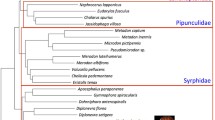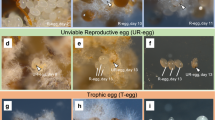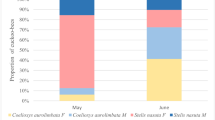Abstract
Adult female mites of the genusTrochometridium Cross possess a pair of internal sacs between the bases of legs III and IV, which are adapted for carrying spores, apparently ascospores, of an undetermined fungus. A three-way symbiotic relationship exists between the mite, the fungus, and various bees (and possibly other holometabolous insects) which nest in relatively dry alkaline soils. The mite transports spores of the fungus to suitable sites for germination — cells of ground-nesting bees containing a bee egg or young larva which dies as a result of development of the fungus and mite. The mite may also stimulate mycelial growth, possibly by killing the young bee or by secreting a substance when feeding. The fungus provides the preferred mycelial substrate on which the mite feeds and undergoes its life cycle. This mutualistic association between the mite and fungus is at the expense of the bee, which transports the other two entities to favorable sites for their development — its newly made and provisioned cells. The sporothecae and specialized association ofTrochometridium mites with a fungal pathogen or saprophyte of another host organism are compared with those ofSiteroptes mites, which are considerably better understood.
Similar content being viewed by others
References
Alfaro, A., 1946. El ácaroPediculopsis graminum Reut. y el hongoNigrospora oryzae (Berk. et Br.) Petch., en asociación parasitaria sobre trigos aragoneses. Bol. Patol. Veg. Entomol. Agríc. Madrid, 14: 321–334.
Batra, L.R., Batra, S.W.T. and Bohart, G.E., 1973. The mycoflora of domesticated and wild bees (Apoidea). Mycopathol. Mycol. Appl., 49: 13–44.
Bridges, J.R. and Moser, J.C., 1983. Role of two phoretic mites in transmission of bluestain fungus,Ceratocystis minor. Ecol. Entomol., 8: 9–12.
Cooper, K.W., 1940. Relations ofPediculopsis graminum andFusarium poae to central bud rot of carnations. Phytopathology, 30: 853–859.
Cross, E.A., 1965. The generic relationships of the family Pyemotidae (Acarina: Trombidiformes). Univ. Kans. Sci. Bull., 45: 29–275.
Cross, E.A. and Bohart, G.E., 1969. Phoretic behavior of four species of alkali bee mites as influenced by season and host sex. J. Kans. Entomol. Soc., 42: 195–219.
Cross, E.A. and Bohart, G.E., 1979. Some observations on the habits and distribution ofTrochometridium Cross, 1965 (Acarina: Pyemotidae). Acarologia, 20: 286–293.
Fennell, D.I., 1973. Chapter 4 — Plectomycetes; Eurotiales. In: G.C. Ainsworth, F.K. Sparrow and A.S. Sussman (Editors), The Fungi — An Advanced Treatise. Academic Press, New York, London, pp. 45–68.
Hawksworth, D.L., Sutton, B.C. and Ainsworth, G.C., 1983. Ainsworth & Bisby's Dictionary of the Fungi. 7th ed. Commonwealth Mycological Institute, Kew, xii+445 pp.
Krantz, G.W., 1957.Dolichocybe keiferi, a new genus and a new species of pyemotid mite, with a description of a new species ofSiteroptes (Acarina: Pyemotidae). Ann. Entomol. Soc. Am., 50: 259–264.
Krantz, G.W., 1978. A Manual of Acarology. 2nd ed. Oregon State Univ. Book Stores, Corvallis, OR, viii+509 pp.
Laemmlen, F.F. and Hall, D.H., 1973. Interdependence of a mite,Siteroptes reniformis, and a fungus,Nigrospora oryzae, in the Nigrospora lint rot of cotton. Phytopathology, 63: 308–315.
Lindquist, E.E., 1983. Some thoughts on the potential for use of mites in biological control, including a modified concept of “parasitoids”. In: M.A. Hoy, G.L. Cunningham and L. Knutson (Editors), Biological Control of Pests by Mites. Univ. Calif., Div. Agric. Nat. Resources, Special Publ. No. 3304, pp. 12–20.
Lindquist, E.E., 1986. The world genera of Tarsonemidae (Acari: Heterostigmata): a morphological, phylogenetic and systematic revision, with a reclassification of familygroup taxa in the heterostigmata. Mem. Entomol. Soc. Can., in press.
Mahunka, S., 1966. Zwei neue Arten aus der Gruppe Tarsonemini aus China (Acari). Vestn. Cesk, Spol. Zool., 30: 315–318.
Mahunka, S., 1970a. Considerations on the systematics of the Tarsonemina and the description of new European taxa (Acari: Trombidiformes). Acta Zool. Acad. Sci., Hung., 16: 137–174.
Mahunka, S., 1970b. Ergebnisse der zoologischen Forschungen von Dr. Z. Kaszab in der Mongolei. 227. Acari: Pygmephoroidea. Ann. Hist.-Nat. Mus. Natl. Hung., 62: 343–362.
Moser, J.C., Cross, E.A. and Roton, L.M., 1971. Biology ofPyemotes parviscolyti (Acarina: Pyemotidae). Entomophaga, 16: 367–379.
Moser, J.C., Kielczewski, Wisniewski, J. and Balazy, S., 1978. EvaluatingPyemotes dryas (Vitzthum 1923) (Acari: Pyemotidae) as a parasite of the southern pine beetle. Int. J. Acarol., 4: 67–70.
OConnor, B.M., 1984. Acarine—fungal relationships: the evolution of symbiotic associations. In: Q. Wheeler and M. Blackwell (Editors), Fungus—Insect Relationships: Perspectives in Ecology and Evolution. Columbia Univ. Press, New York, pp. 354–381.
Rozen, J.G., Jr., 1958. Monographic study of the genusNomadopsis Ashmead (Hymenoptera: Andrenidae). Univ. Calif., Berkeley, Publ. Entomol. 15: 1–202.
Seemüller, E., 1968. Untersuchungen über die morphologische und biologische Differenzierung in derFusarium-SektionSporotrichiella. Mitt. Biol. Bundesanst. Land Forstwirtsch. Berlin-Dahlem, 127, 93 pp.
Shinn, A.F., 1967. A revision of the bee genusCalliopsis and the biology and ecology ofC. andreniformis (Hymenoptera, Andrenidae). Univ. Kans. Sci. Bull., 46: 753–936.
Su, T.Z., Beng, G.Y. and Chen, X.D., 1979. Zhong goo sui man shu chu ji. [Notes on the genusSiteroptes in China.] (Acarina: Pyemotidae). Acta Zootaxon. Sinica, 4: 162–169 (in Chinese with English summary).
Su, T.Z., Chen, X.D. and Beng, C.Y., 1981. He gu sui fu bing zhong sui man tu bing yuan jun gong sheng guan xi di yan jiu. (The symbiotic relationships between mites and fungi in the ear rot of grasses.] Acta Phytopathol. Sinica, 11: 19–24 (in Chinese with English summary).
Suski, Z.W., 1973. A revision ofSiteroptes cerealium (Kirchner) complex (Acarina, Heterostigmata, Pyemotidae). Ann. Zool. (Warsaw), 30: 509–535.
Sussman, A.S., 1966. Types of dormancy as represented by conidia and ascospores ofNeurospora. In: M.F. Madelin (Editor), The Fungus Spore. Butterworths, London, pp. 235–257.
Author information
Authors and Affiliations
Rights and permissions
About this article
Cite this article
Lindquist, E.E. Discovery of sporothecae in adult femaleTrochometridium Cross, with notes on analogous structures inSiteroptes Amerling (Acari: Heterostigmata). Exp Appl Acarol 1, 73–85 (1985). https://doi.org/10.1007/BF01262201
Accepted:
Issue Date:
DOI: https://doi.org/10.1007/BF01262201




